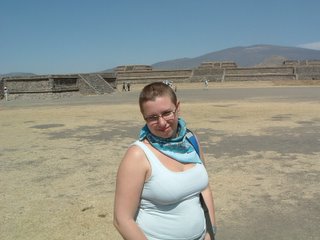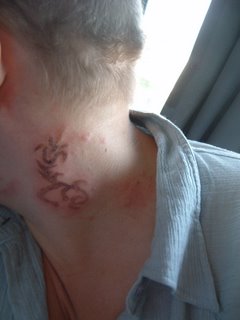We have now been in Mexico City for four or five days, and it's been fantastic. Miles upon miles of street markets, street food that even vegetarians can enjoy, music everywhere and the most hustly bustle I've ever seen. We're staying in the historical centre, near the Zocalo - a plaza that seems to be the equivalent of Leicester Square plonked in the middle of Westminster. Surrounded by government buildings, the square fills with Aztec dancers, vendors of miscellaneous tat and political protestors targeting the presidential offices.
Lizzie is in a slightly sorry state today. She has succumbed to our first bout of food poisoning - nothing serious, but I've left her dozing with several gallons of water and coke to keep her company. Meanwhile, I thought I'd fill you in on one of my personal highlights to date - Mexican wrestling.
I've been interested in professional wrestling for years, since the early 90s when Sky started showing the WWF. This was when Hulk Hogan still ruled the roost, and the shows were cartoon-like and simple to follow - but the feuds were compelling. Faces (good guys) would be locked in a vendetta with heels (the bad guys). Not that I knew the terminology back then, I just enjoyed the drama and the atheleticism. Sure, it didn't quite seem like a real sport - it was better than that.
Years later, I started idly surfing the internet to find out what this show was really all about. I discovered sites full of backstage gossip, explaining who was playing politics to win or keep the championship, why the writers were all morons, and the real reasons performers would leave (storyline: suspension. real reason: making movies). The last 10 years were momentous in the wrestling world. The rise of the internet had lifted the curtain, and no-one but a few old-timers would even pretend that it was on the level. The WWF had even started a Pop Idol style contest to find new wrestlers, revealing the tricks of the trade to an MTV audience.
I kept looking, and discovered a community of old-school wrestling fans. These guys hate the WWF, and look back to their childhood viewing in the 50s and 60s and 70s, and even further back. I learnt that professional (i.e. fake, though they don't like that word) wrestling dates backs over a century, to travelling carnivals where two wrestlers would put on a show every night. They had to fake it. First, there was no way that their bodies could stand up the punishment of a true contest on a nightly basis. Second, true shootfighting is very slow and dull to watch. It could go on for hours, with two men laying on the ground and hardly twitching.
But these guys could really fight too. Part of the show would be for an audience member to challenge one of the wrestlers for prize money, and of course it wouldn't do for a punter to walk away with the purse.
Different territories around the US emerged over time, each running their own shows with their own local heros. A national champion would go from area to area defending his title - this guy also had to be the real thing, as local tough guys were liable to try it on and steal the championship given half a chance. More and more showbiz crept in. By the 1980s, Vince McMahon expanded his New York promotion to a national spectacle with Wrestlemania, putting most of the other groups out of business and eventually creating an international presence.
I haven't actually watched much wrestling in years, but the world of it fascinates me. Somewhere between sport, circus and theatre, it's like nothing else. Or perhaps, everything else. Once you understand the concept of Kayfabe - the pretence that this is all real, though everyone kind of knows it's a show - it gives you a new perspective on politics and all aspects of society. You start seeing George Bush 'cut a promo' on Saddam rather than give a speech about Iraq. You start seeing Question Time as the equivalent of Smackdown, with the on-screen opponents playing carefully rehearsed parts and giving away nothing of their backstage relationships.
But wrestling is not confined to America, and it isn't all in the WWF mould. Lucha Libre (free fighting) is a huge sport here - second only to football. And it's a much simpler style. Most of the wrestlers wear masks. There are no chairs or weapons, a great deal of high-flying atheleticism, and a large element of comedy. It's not particularly realistic, but it's a lot of fun and the crowds lose themselves in it week after week.

I'd never seen a live show before, and figured Mexico would be a good place to start. I turned up at the Arena Coliseo for the Sunday show - having gathered that this was the top place to see the stars. My cheap Balcon ticket bought me a seat on a concrete step in a tatty arena, alive with candyfloss hawkers and tooting horns. There was a wire mesh between us and the ring, presumably to catch projectiles. There were probably 1500 people there, a near-full house in any case. The show was being filmed for TV, and consisted mostly of trios - tag teams with 3 on each side. In theory, I believe only two guys should be in the ring at the same time. But this was rarely observed, and the two referees appear to be both ineffectual and rather dense. All part of the show.
I was nervous beforehand, about the violence, about the crowd. But the whole thing was incredibly good natured. The crowd smiled as they booed, laughed as a fat comic wrestler did his shtick, being thrown out of the ring and falling onto the poor punters in the front row. They roared as one heel would hold a face down to be attacked, only for the face to escape at the last minute leaving the two villains to collide. They booed and barracked as one wrestler was carried out on a stretcher, and his opponent kicked him off. And at the end, everyone left satisfied.
It was more like Panto than sport, but the acrobatics were impressive, and every match had both comedy and drama. I didn't know who anyone was, or anything about the backstage politics. It was just a wrestling show, and it reminded me how to enjoy that.
To end, a few shots of Mexico city. Then I'd best be off to check on the wife. Next stop, Oaxaca and - we hope - a nice tranquil beach cabana to read and write and think in.


















 Unfortunately, the windows were both dirty and reflective, and you cant capture that kind of thing. Still, you get the idea. We passed another 5 or 6 hours enjoying this kind of splendour, before stopping in the mountain town of Creel.
Unfortunately, the windows were both dirty and reflective, and you cant capture that kind of thing. Still, you get the idea. We passed another 5 or 6 hours enjoying this kind of splendour, before stopping in the mountain town of Creel.





 We´re now at the bottom of Baja, enjoying the beaches of La Paz before heading to the mainland and the Copper Canyon Railway.
We´re now at the bottom of Baja, enjoying the beaches of La Paz before heading to the mainland and the Copper Canyon Railway.
